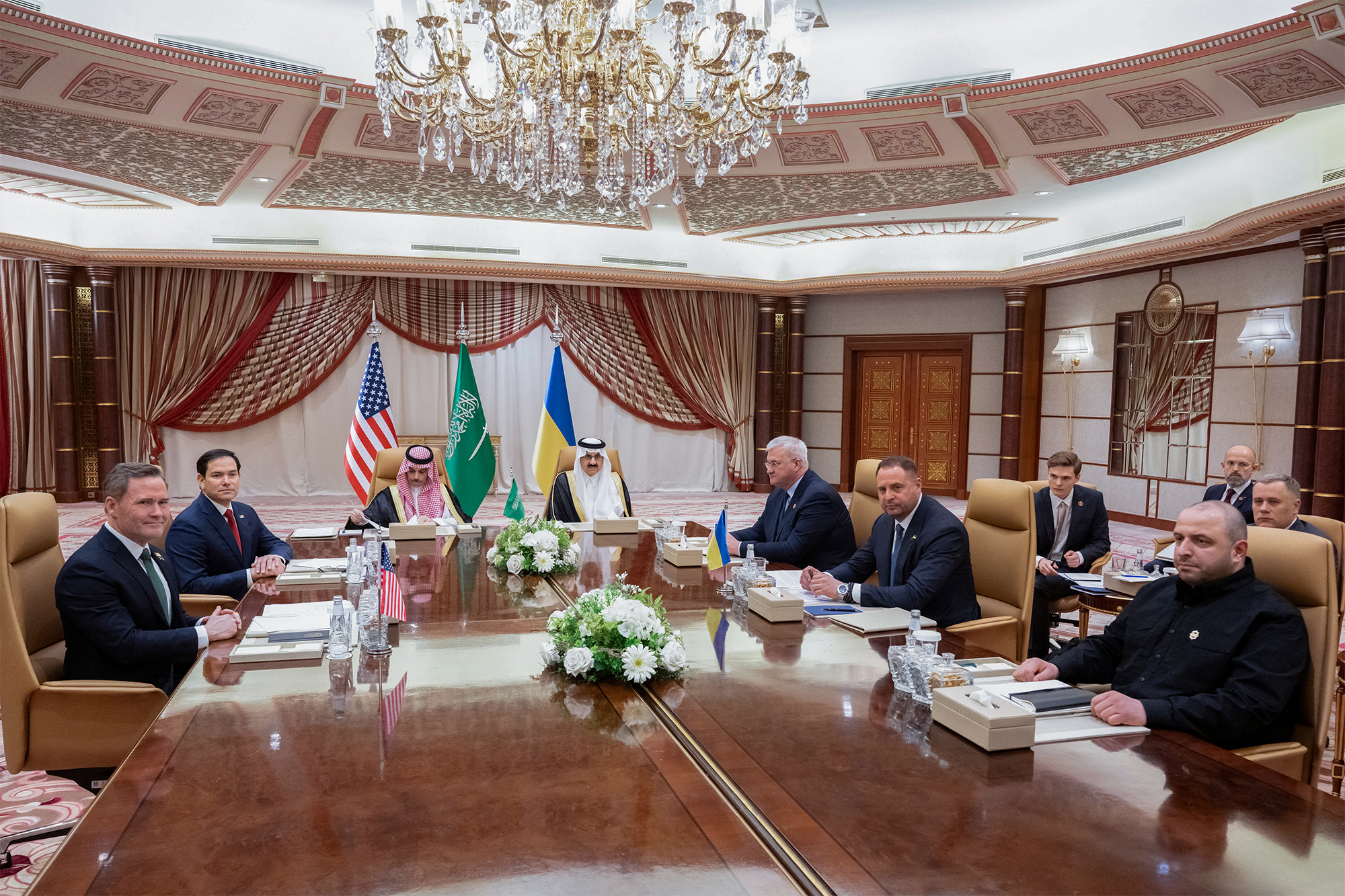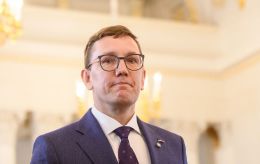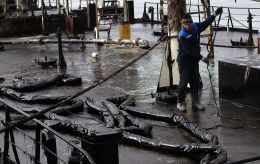Ceasefire talks: Insights from Trump, Zelenskyy and Putin
 Photo: Donald Trump, President of the United States (Getty Images)
Photo: Donald Trump, President of the United States (Getty Images)
The topic of the ceasefire between Ukraine and Russia was the leitmotif of a series of meetings in Saudi Arabia. As a result, an energy truce was agreed upon with the mediation of the United States.
More about whether the agreements are working and what the United States, Ukraine, and Russia say about the ceasefire in the RBC-Ukraine article below.
Contents
- From a complete ceasefire to an energy truce
- Ukraine's position
- What Putin says
- US position on war in Ukraine
From a complete ceasefire to an energy truce
In recent months, several meetings have taken place with the participation of US delegations, which separately negotiated with Ukraine and Russia as part of "shuttle diplomacy." Thus, on February 18, 2025, a high-level US-Russian meeting was held in Riyadh (the capital of Saudi Arabia).
The American side was led by US Secretary of State Marco Rubio, and the Russian side by Foreign Minister Sergei Lavrov. The main topic of their discussion was improving relations between the two countries and finding ways to end the war in Ukraine.
Notably, the Ukrainian delegation was not invited to this summit, which caused concern on the part of Kyiv. US President Donald Trump dismissed these concerns, hinting at Ukraine's "responsibility" for the outbreak of the conflict.
However, on March 11, 2025, the US and Ukrainian delegations met in Jeddah, Saudi Arabia. During these talks, the Americans proposed a 30-day ceasefire along the entire front line with the possibility of extension.
Ukrainian President Volodymyr Zelenskyy, who had initially proposed a ceasefire in the sky and at sea, welcomed this initiative. Thus, Ukraine agreed to such a step, but only on the condition that Russia agreed to it. In response to Kyiv's agreement, the Americans announced the resumption of military assistance and intelligence sharing with Ukraine.
After that, the United States began communicating the essence of the negotiations to the Kremlin. Trump sent his special envoy Steve Witkoff to Russian dictator Vladimir Putin, through whom the Kremlin conveyed its own “signals” to the US president, the content of which was not disclosed.
Putin publicly said that he “agreed” with the idea of a truce, but at the same time stated that there were ‘nuances’, namely the need to stop mobilization in Ukraine and “rearm” the Armed Forces.
The Kremlin media also reported that the dictator had allegedly demanded a complete halt to military aid to Ukraine. However, Trump denied this, saying that there was no question of aid at all.

Photo: meeting between the delegations of Ukraine and the United States in Saudi Arabia on March 11 (Getty Images)
After Witkoff visited Moscow, the US president and the Kremlin leader spoke. Their conversation took place on March 18 and lasted more than two hours. Trump said he had agreed with Putin on an immediate ceasefire at all energy and infrastructure facilities.
The “shuttle diplomacy” continued. On March 23, a Ukrainian technical group held talks with the United States, and on March 24, the Americans continued negotiations with the Russians, followed by Washington's consultations with Kyiv on March 25.
The meetings of the technical groups in Saudi Arabia on March 23-25 did not result in a comprehensive ceasefire for 30 days, as Trump had wanted, but the parties agreed to stop strikes on energy infrastructure and ensure the safety of navigation in the Black Sea.
However, in the case of Russia, traditionally, things were not so clear-cut. The Kremlin once again began to make demands, stating that the truce in the Black Sea would take effect after the lifting of sanctions against Rosselkhozbank and other Russian financial organizations involved in international food trade.
Ukraine's position
As the president explained earlier, Ukraine agreed to a comprehensive ceasefire with Russia (subject to the Kremlin's consent) to make it clear to the world that Putin does not want peace. Zelenskyy explained that Kyiv had initially proposed a ceasefire in the sky and at sea because it was easier to monitor.
According to the President, a ceasefire could create a “window of opportunity” to develop a peace plan and end the war. However, this requires reciprocal steps from Russia, which does not want peace.
Moreover, there were disagreements about the date of entry into force of the ceasefire. Russia claimed that it began on March 18 after a telephone conversation between Putin and Trump. On the other hand, Ukraine insists that the ceasefire came into effect on March 25, after technical talks in Saudi Arabia. Washington's statement did not specify the exact dates.
However, since then, Russia has repeatedly attacked Ukrainian energy facilities, in particular in Kharkiv and Kherson, and in the latter yesterday, the aggressor left 45,000 residents without electricity. It should be noted that the Presidential Administration warned the Russians of "symmetrical responses" if they violate the agreements.
.jpg)
Photo: Zelenskyy calls on partners to put quick pressure on Russia (Vitaliy Nosach, RBC-Ukraine)
Today, after another round of targeted attacks by the aggressor and damage to energy facilities, the President of Ukraine called for "pressing" the Russian dictator to give a real order to stop the strikes, as the occupiers continue to strike after the US ceasefire proposal.
"Now, after the last meeting in Saudi Arabia, in Jeddah, it is clear to absolutely everyone in the world that Russia is the only one who is dragging out this war. The only one who brought it here and who needs to continue it. Since March 11, there has been a proposal for an unconditional ceasefire, and such attacks would have stopped by now. But it is Russia that continues all this," Zelenskyy said.
According to the Head of State, Ukraine has provided the United States with confirmation of Russia's strikes on energy infrastructure, which violates the ceasefire agreement, and is waiting for a response from Washington.
What Putin says
The Kremlin, on the other hand, says that Putin supported Trump's proposal and, after a conversation with him on March 18, allegedly "gave the appropriate order to the military" to stop strikes on the energy sector for 30 days.
The Russian Ministry of Defense even cynically claimed that after Putin's order, they “shot down” their own drones that were flying at the energy sector in Mykolaiv region. However, in fact, that night, the Russians attacked energy facilities, transportation, hospitals, and urban infrastructure in Ukraine.
Moscow cynically accuses Kyiv of violating the agreements. Yesterday, Russian Foreign Minister Lavrov complained about Ukraine to the United States, the UN, and the OSCE over what he called “Ukraine's violation of the agreement on the inadmissibility of attacks on energy infrastructure.”
"Energy facilities have been under attack all this time, perhaps with a break of one or two days. We have passed this list to US Presidential Assistant Mike Volz.
I sent it to US Secretary of State Marco Rubio, our representatives to the UN and the OSCE," Lavrov said.

Photo: Putin is deliberately setting conditions to stall for time (Getty Images)
In addition, Russia is beginning to criticize Trump's approach to ending the war in Ukraine.
"The US position on Ukraine currently lacks a requirement to address the root causes of the conflict, which must be overcome. Moscow takes Washington's proposals on Ukraine seriously, but it cannot accept them as they are," Russian Deputy Foreign Minister Sergei Ryabkov said.
The Kremlin is also criticizing the United States, accusing the American side of “not responding” to Russia's accusations that Ukraine is violating the energy truce.
"The moratorium on strikes on Ukraine's energy sector is still in effect, and Russia is complying with it. There has been no US reaction to the ongoing strikes by the Ukrainian Armed Forces on Russian energy facilities," Peskov fantasized.
US position on war in Ukraine
According to Western media, Trump is trying to achieve a comprehensive ceasefire in Ukraine by Easter (April 20). So far, however, he has not succeeded in forcing Russia to comply even with the energy ceasefire.
In an interview with NBC, the US president said he was angry with Putin because he did not want to negotiate with Zelenskyy and questioned his legitimacy (the Russian dictator proposed to establish an external administration in Ukraine by the UN and other countries to hold elections).
“If Russia and I are unable to make a deal on stopping the bloodshed in Ukraine, and if I think it was Russia's fault — which it might not be — but if I think it was Russia’s fault, I am going to put secondary tariffs on oil, on all oil coming out of Russia,” NBC quoted Trump as saying.
The head of the White House noted that the duties against Russia would take effect within a month if there is no ceasefire agreement. He also said he was going to talk to Putin again.
Notably, Finnish President Alexander Stubb, after a seven-hour meeting with the US President while playing golf, said that Washington was developing sanctions against Russia in case it refuses to abandon the ceasefire in Ukraine or violates it.
At the same time, the White House says that Trump is dissatisfied with the statements about the war made by both Putin and Zelenskyy.
"He expressed his dissatisfaction with the leaders' comments of both sides of this conflict. He expressed what he believes needs to happen for this conflict to end. He continues to work hard on that, and our teams continue to work," said White House spokeswoman Caroline Levitt.

Photo: Trump says there is a "psychological deadline" for Russia to agree to a deal (Getty Images)
At the same time, according to Fox News, the US president is disappointed with Putin's position and believes that Russia is deliberately delaying comprehensive ceasefire talks.
The Trump administration does not rule out that the United States will not be able to conclude a peace agreement on Ukraine in the next few months and is developing new pressure mechanisms on Kyiv and Moscow, Reuters reports.
“I'm told that sanctions enforcement is low at the moment - unofficially estimated at ‘3 out of 10’ - and that banning Russia's ‘shadow fleet’ that transports illegal oil through the Baltic Sea would be an easy target for pressure,” said Fox News journalist Jackie Heinrich at the White House.
Meanwhile, the head of the Russian Direct Investment Fund (RDIF), one of the Kremlin's negotiators, Kirill Dmitriev, will visit Washington. His visit was announced by CNN, citing sources. According to the media, Dmitriev may meet with Vitkoff, and the parties will discuss relations between the two countries and the end of the war against Ukraine.
Since Dmitriev is under US sanctions, the US government has temporarily lifted the restrictions to allow the State Department to issue a visa to the Russian official, CNN said.
This will be the first official visit of a senior Russian official to the United States since Russia's full-scale invasion of Ukraine.
Sources: Associated Press, CNN, Reuters, Fox News, NBC, Bloomberg.

